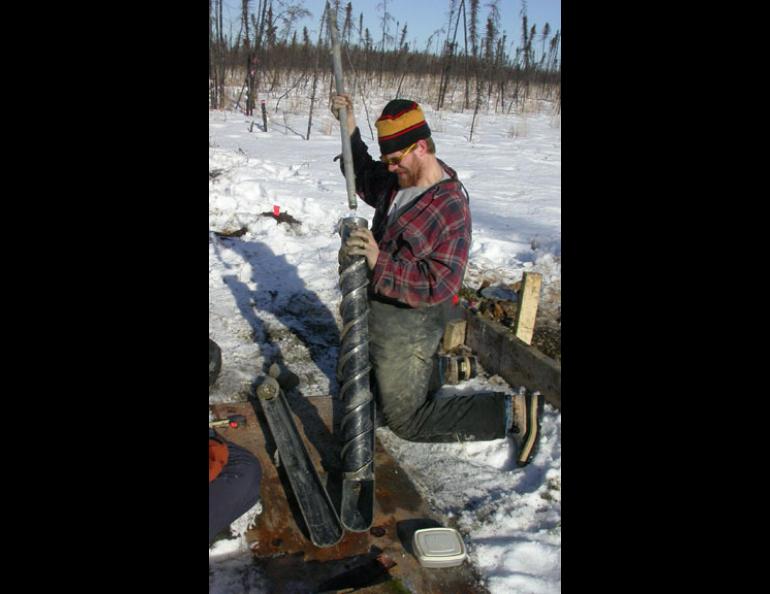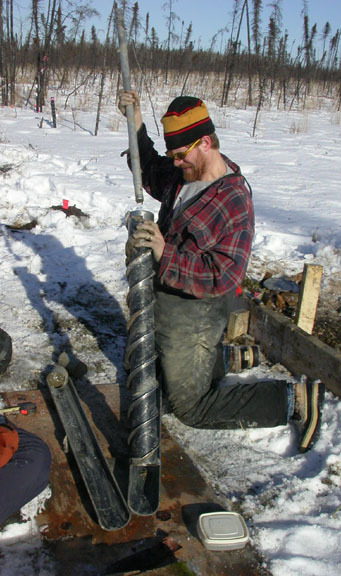
Bogs, Permafrost and the Global Carbon Equation
The spring equinox sun beat down on the white blanket covering Tanana Flats as Jamie Hollingsworth leaned a power auger into a frozen bog. He and other scientists had traveled to these lowlands south of Fairbanks to learn more about the fate of carbon in the north.
Hollingsworth, a technician with the Bonanza Creek Long Term Ecological Research Site, pulled a hollow drill bit from the ground and then pushed out its core-a brown-and-gray cylinder as thick as a soup can. The plug of earth was three feet long and veined with tiny ice lenses. Soil scientist Jennifer Harden, of the U.S. Geological Survey, and UAF graduate student Isla Myers-Smith handled the soil sample as they would a newborn baby, easing it to a cradle made of PVC pipe. To them, that frozen chunk of Tanana Flats held answers about how carbon moves through the northland.
Carbon warms the planet in the form of carbon dioxide floating in the atmosphere. Carbon dioxide, a byproduct of fossil fuel burning, breathing, and plant decomposition, is a major gas responsible for the greenhouse effect because it allows incoming solar radiation to pass through while trapping the heat radiated back from the ground.
Scientists know that more carbon in the atmosphere means a warmer planet. Many researchers have modeled the effects of increases in manmade carbon dioxide, and they've come up with some scary projections of future warming. Others, such as Harden and Myers-Smith, are attempting to figure out how wildfires, bogs, and other northern systems affect the global budget of carbon. The answer is significant because an immense amount of carbon is locked in frozen northern soils in the form of plant matter that has not yet decayed.
Blackened spruce snags surround the Tanana Flats bog researchers are studying. The Survey Line Fire of 2001 swept through the flats, blackening everything around the study area except the bogs, which look like mint-green circles from the air. Harden thinks these bogs may expand as a result of the fire, and she is studying the underground world to see if fires speed up the creation and growth of bogs.
The circular bogs are among the most drastic of the changes affecting Tanana Flats and other lowland areas in Alaska. Here's how they form: After permafrost melts, the ground above it collapses and the site collects water, creating a good environment for moss. When moss is established, it creates acidic, cold soil that excludes other plants. Once established, a bog can expand at an impressive rate. Harden found that the "moat" encircling the bog on which she was working had expanded its boundaries by more than one meter in just one year.
With future warming, Tanana Flats-an area the size of some U.S. counties-could become one huge bog complex, Harden said. The transition would turn the flats into what scientists refer to as a "carbon sink," a place that absorbs more carbon than it emits.
To find out more about the evolution of the bogs and how fire might speed up the process, Harden and Myers-Smith will slice up the frozen cores of soil from the Tanana Flats in a UAF lab and examine them under a microscope. Those frozen cylinders of soil will give them a good idea of how bogs-which may become a much more common in the northern landscape-are affecting the world's supply of greenhouse gases.





